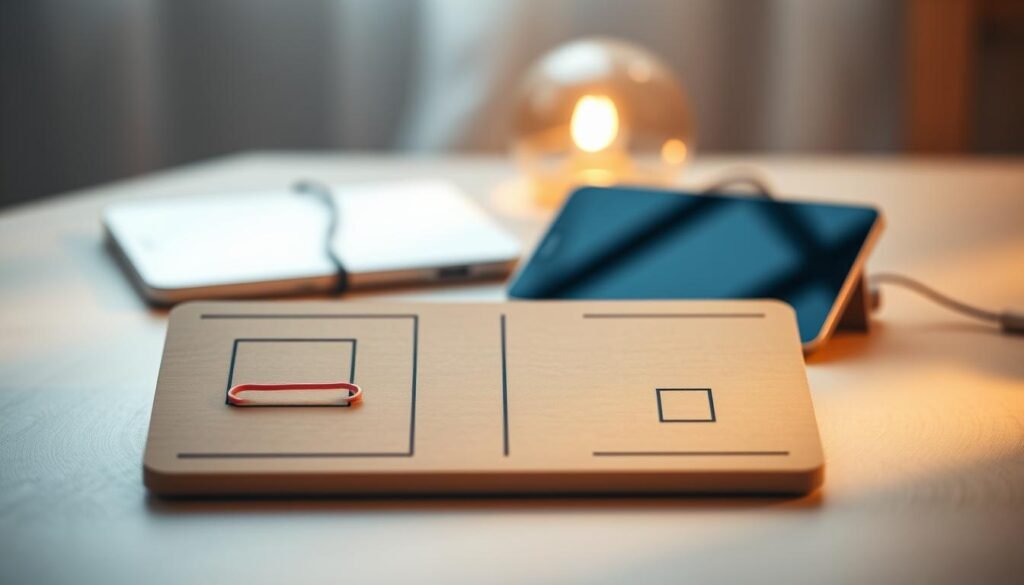Let’s face it: screens rule our lives. Between buzzing phones, endless emails, and social media alerts, staying focused feels like a full-time job. Digital distractions don’t just steal time—they chip away at creativity, relationships, and peace of mind.
You’re not alone if you’ve ever lost hours scrolling or missed deadlines because of constant interruptions. Modern devices help us connect but also create a nonstop tug-of-war for attention. The good news? Small changes can make a big difference.
This guide shares simple, real-world strategies to reclaim your day. You’ll learn how to silence the noise, prioritize what matters, and protect your mental space. No extreme detoxes or complicated apps—just practical steps that fit into busy lives.
Key Takeaways
- Digital interruptions cost time and reduce work quality
- Smartphone alerts trigger stress responses in the brain
- Focus improves when you control device access
- Physical environment changes boost concentration
- Regular tech breaks prevent mental fatigue
- Boundaries help maintain work-life balance
Ready to cut through the clutter? These methods work whether you’re studying, working remotely, or just wanting to enjoy dinner without screens. Let’s dive into solutions that stick.
Introduction to Digital Distractions
Our devices buzz, ping, and flash—demanding attention at every turn. These interruptions aren’t just annoying; they rewire how we think and interact. Let’s unpack what makes modern distractions so powerful and why tackling them matters.
What Counts as a Digital Distraction?
Digital distractions are any alerts, apps, or content that pull you away from priorities. Think texts during work hours, YouTube rabbit holes, or endless email refreshes. They’re designed to hook us:
| Distraction Type | Average Daily Interruptions | Common Triggers |
|---|---|---|
| Social Media | 12+ checks/hour | Likes, comments |
| 6-8 inbox visits | New message alerts | |
| Streaming | 3+ hours/day | Autoplay features |
“Notifications act like slot machines for our brains—we keep checking for that dopamine hit,” notes behavioral researcher Dr. Ellen Parks.
The Hidden Cost of Constant Interruptions
Every ping steals time and mental energy. Studies show it takes 23 minutes to refocus after a single disruption. Over a workday, that adds up to hours lost. Worse, fractured attention lowers creativity and problem-solving skills.
| Impact Area | Before Reduction | After Reduction |
|---|---|---|
| Task Completion | 42% slower | 68% faster |
| Stress Levels | High | Moderate |
| Creative Output | Limited | Enhanced |
By managing these interruptions, you protect your productivity and mental clarity. It’s not about quitting tech—it’s about using it on your terms.
Understanding the Impact on Focus and Productivity
Imagine losing nearly half an hour every time your phone buzzes—that’s the reality of modern work. Research from the University of California, Irvine shows it takes 23 minutes and 15 seconds to regain peak concentration after a single interruption. That “quick” email check during lunch? It might cost you an entire episode of mental catch-up.
The Disruption of Concentration
Our brains aren’t wired for constant switching. Each alert forces a cognitive reboot—like restarting a computer mid-task. This isn’t just about lost time. Rushed work after interruptions contains 40% more errors, according to workflow studies.
Economic and Personal Productivity Insights
McKinsey & Company found that smarter tech habits could unlock $1.3 trillion in global productivity annually. For context:
- 3 daily interruptions = 69 lost minutes
- 5 alerts = 2+ hours of recovery time
- 8 checks = 3+ hours of mental tax
“The gap between potential and actual output isn’t about working harder—it’s about working smarter with technology.”
This isn’t just a business issue. Personal projects take 50% longer when fragmented by notifications. The solution lies in protecting your attention span—not eliminating tools.
Causes of Digital Distractions
We carry potential interruptions in our pockets daily. The same tools meant to streamline tasks often sabotage focus through endless options. Let’s break down why modern tech makes concentration feel like swimming upstream.
Access to Multiple Technologies
Our homes now double as tech playgrounds. Remote workers juggle smartphones, tablets, and streaming services alongside job tools. An OSlash survey found 58% of Americans blame social media for derailing productivity, while 51% point to relentless notifications.
Consider this breakdown of common culprits:
| Device/Platform | % Reporting Distraction |
|---|---|
| Social Media Apps | 58% |
| Email & Messaging | 51% |
| Streaming Services | 37% |
Client Pressures and Continuous Connectivity
Many feel tethered to round-the-clock availability. Urgent pings from colleagues or clients create a false sense of emergency. One project manager shared:
“My team expects replies within minutes—even for non-critical issues.”
This “always-on” culture trains brains to prioritize reactions over deep work. Productivity becomes measured in response speed rather than output quality.
The Role of Digital Addiction
Tech companies design apps to hook users through psychological tricks. Variable rewards (likes, message alerts) trigger dopamine releases similar to gambling. Over time, this creates compulsive checking habits—even during focused tasks.
Key factors driving this cycle:
- FOMO (fear of missing out) on updates
- Autoplay features that override self-control
- Personalized content algorithms
[5 Easy Ways to Reduce Digital Distractions Today]: A Strategic Approach
Breaking free from constant interruptions starts with smart systems, not just willpower. These research-backed methods form a layered defense against modern tech temptations:

Overview of the 5 Key Strategies
The most effective approach combines environmental tweaks with behavioral shifts. Think of these strategies as building blocks—each one strengthens your ability to concentrate.
| Strategy | Key Action | Immediate Benefit |
|---|---|---|
| Notification Management | Silence non-urgent alerts | Fewer interruptions |
| Time Blocking | Schedule focus periods | Better task completion |
| Physical Workspace Design | Separate devices by zone | Reduced visual triggers |
| Mindful Browsing | Set app timers | Less accidental scrolling |
| Accountability Systems | Use progress trackers | Increased motivation |
These methods work best when combined. For example, silencing notifications during scheduled work hours makes time blocking more effective. Start with one strategy and layer others gradually.
“Consistency beats intensity every time. Small daily improvements create lasting change.”
Expect occasional slip-ups—that’s normal. Focus on progress, not perfection. Most people see measurable improvements in concentration within 14 days of consistent practice.
Managing Notifications and Social Media Overload
Notifications are modern-day traps disguised as helpful alerts. App developers design these pings to keep you hooked, not to boost efficiency. Start by auditing your devices—you’ll likely find dozens of unnecessary interruptions stealing your focus daily.
Turning Off Non-Essential Notifications
Begin with your phone’s settings. Disable alerts from apps that don’t require instant replies—shopping platforms, games, or news feeds. Social media platforms are the worst offenders, using red dots and vibrations to trigger compulsive checks.
Here’s a quick reset plan:
- Review notification permissions weekly
- Silence group chats and promotional emails
- Enable “Focus Mode” during work hours
“Default settings favor corporate profits, not your productivity. Take charge of what gets your attention.”
Limiting Social Media Usage Effectively
Keep platforms accessible but less tempting. Delete apps from your phone but keep them on your computer. Schedule 15-minute check-ins twice daily instead of constant scrolling. Curate feeds to show only valuable content—mute noisy accounts.
Combat FOMO by:
- Setting app timers with hard stops
- Using grayscale mode to reduce visual appeal
- Planning real-world activities during breaks
These tweaks help break the time-sucking cycle while preserving connections that matter. Your brain will thank you for the breathing room.
Implementing Digital Detox Breaks and Focus Periods
What if stepping away from screens could actually make you more efficient? Research reveals planned disconnection boosts mental clarity by 34% compared to constant connectivity. Strategic breaks act like a system reboot for your brain—refreshing focus without sacrificing productivity.

Scheduling Regular Digital Breaks
Think of tech-free intervals as work enhancers, not interruptions. The Pomodoro Technique proves effective: 25 minutes of focused effort followed by 5-minute device-free breaks. During these pauses:
- Stretch or grab water instead of scrolling
- Use physical timers to avoid phone checks
- Schedule email reviews for specific hours
“Our brains process information better when given rhythmic rest periods,” explains productivity coach Mara Lin.
| Break Strategy | Time Investment | Focus Boost |
|---|---|---|
| Micro-breaks | 5 mins/hour | 22% increase |
| Lunch reset | 30 mins midday | 41% stamina gain |
| End-of-day wind-down | 15 mins | Better sleep quality |
Setting Boundaries with Do Not Disturb Modes
Modern devices offer smart silence features. Customize “Focus Mode” to:
- Block social alerts during deep work hours
- Allow calls from key contacts
- Auto-reply to non-urgent messages
Combat FOMO by scheduling two 10-minute check-ins daily. Inform colleagues: “I respond fastest between 2-3 PM.” This maintains professionalism while protecting your schedule.
Remember: Boundaries aren’t rigid walls—they’re filters letting through what truly matters. Start with 90-minute focus blocks and expand as your concentration muscles strengthen.
Optimizing Digital Communication Tools
The average worker spends nearly 2.5 hours daily managing work emails—time that could fuel meaningful projects. Smart system adjustments can slash this burden while improving response quality. Start by treating your inbox like a workflow tool, not a taskmaster.
Email Management and Inbox Prioritization
Transform your inbox with automated sorting. Create filters that route messages to labeled folders based on sender or keywords. For example:
| Email Category | Action |
|---|---|
| Newsletters | Archive automatically |
| Team Updates | Move to “Review PM” folder |
| Client Requests | Flag as urgent |
Apply the two-minute rule: Reply immediately to quick emails, batch others for scheduled sessions. Schedule outgoing messages during your recipient’s active hours using delay send features.
Simplifying Messaging Apps and Notifications
Audit your tools. Do you really need 4 chat apps? Consolidate platforms and mute non-essential group channels. Set clear expectations with colleagues:
- “Slack for quick questions”
- Email for formal requests
- SMS for true emergencies
“Clarity reduces 73% of unnecessary pings,” reports a HubSpot workflow study.
Turn off read receipts and typing indicators. These features create artificial urgency, pressuring users into instant replies. Reclaim control by designating two 15-minute windows daily for messages.
Leveraging Productivity and Goal-Setting Apps
Smart technology can be your ally in fighting focus-stealing habits. The right apps act like digital bodyguards—blocking distractions while keeping essential tools accessible. Let’s explore solutions that simplify workflows instead of complicating them.
Tools That Enhance Task Management
Modern task managers go beyond basic to-do lists. Look for apps that auto-sort priorities using deadlines or project types. Features like calendar sync and progress tracking turn chaotic workloads into clear action steps.
One designer shared: “My app hides social media until I finish three tasks.” This forced focus helps maintain momentum without constant willpower checks. Just ensure your chosen tool minimizes notifications to prevent new distractions.
Tracking Time for Focused Work
Screen-based timers often backfire by tempting users to browse. Physical devices like TimeFlip solve this—flip it to start tracking without touching your phone. This analog approach maintains awareness of time spent on different tasks.
Whether digital or tactile, effective trackers help stay accountable. Pair them with scheduled reviews to spot patterns. Remember: The goal isn’t perfection, but progress toward sustained productivity.

![[5 Easy Ways to Reduce Digital Distractions Today]](https://upgrademyfocus.com/wp-content/uploads/2025/07/5-Easy-Ways-to-Reduce-Digital-Distractions-Today.jpeg)